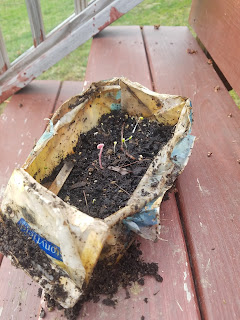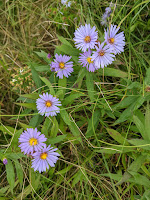2020 Plants I am growing from seeds!
I post the plants I start from seeds every year and, if I am lucky, only 1 or 2 people take me up on my offer for free plants. I think people do not feel comfortable taking something offered for free. I am not really sure. But from my perspective, I offer plants for free because I want to help slow the decline of nature and the more the yards around our neighborhoods can feed caterpillars, the more butterflies there will be for me. I am really being selfish, right? Well not really, but it would be a great reward not only to see my seedlings grow and feed butterflies, but also to know that somewhere out in our suburban jungle, they might be doing the same. So don't hesitate to contact me if any of these plants may interest you. I have some good ones this year and hopefully a few that I have started from wild seeds.
From the Wild Seed Project, which uses seeds collected in Maine:

From the Wild Seed Project, which uses seeds collected in Maine:

Boneset (Eupatorium perfoliatum). This is a striking native plant that is valued as nectar source for many butterflies. According to North American Butterfly Association, it is not considered a host plant. The NWF Plant Finder suggests otherwise. I am not sure. This plant prefers wet to moist soils like its cousin, joe pye weed, and tolerates partial shade.
Bee-balms Wild bergamot (Monarda fistulosa). This a great plant for full sun, well drained sites. There are 9 species of butterflies and moths that use this as a host plant. It is also a valuable nectar plant.
Asters Flax-leaved stiff-aster (Ionactis linariifolia). This is one of those beautiful native plants that reminds us that there are no hybrids or cultivars more beautiful than what nature already produces. According to the Native Plant Trust, Native Plants for New England Gardens, asters are host to many caterpillars, second only to the goldenrods in our region. This is another plant that does well in dry, well drained, sunny sites.
Rudbeckia hirta var pulcherima. I'm very excited to grow this variety of black eyed susans from a native maine population. In my experience black eyed susans don't qualify as "pollinator magnets" - a term that I dislike - but they make up for what they lack in instant gratification with the longevity of their flowers and the species they attract if you are patient. You can think that they are inactive then you notice small caterpillars boring into their flowerheads. I'm excited to grow a local population in my front yard. Did I say that already? 14 species of moths and butterflies use Rudbeckias as a host plant.
From Prairie Moon Nursery:
 Lupinus perennis. Native lupines are host plants for blues and sulphurs which are such elegant creatures. You garden will feel complete when they visit. You should know that the native lupines have 9 to 13 lobes on their leaves. Any more than that and you have the european variety that hosts no insects and provides no ecologicial value. I'm growing more of these because they get easily crowded out and they have such tremendous value.
Lupinus perennis. Native lupines are host plants for blues and sulphurs which are such elegant creatures. You garden will feel complete when they visit. You should know that the native lupines have 9 to 13 lobes on their leaves. Any more than that and you have the european variety that hosts no insects and provides no ecologicial value. I'm growing more of these because they get easily crowded out and they have such tremendous value.
Tall thistle, cirsium altissimum. Thistles are often maligned because of the invasive canada thistle, but they are extremely valuable to both bees and butterflies for both habitat and nectar. The Xerces Society has written a great article on their value. All I want to show you is this and this video from an island off the coast of maine where even the invasive canada thistle was thing to behold. Thistles feed butterflies, bees and birds like gold finches, but they are biennials so they require the patience to grow for a second season before they will flower. I can't wait for this year which will be my second. They are host plants for painted ladies and many others.
Heliopsis helianthoides. This is a sunflower that is native to the new england region and I am going to grow it to see how it works. I love my sunflowers so much because they bees of many varieties sleep in them and life around them is abundant to the end of the season. It is called 'early' sunflower because it should bloom in June which will help cover the period before the late summer flowers bloom. That can really help bee populations take advantage of the flowers that come later.
From Wild Seeds I collected:
ok, I need to follow up on this. I have another 10 or so varieties I am growing from seeds i collected this summer. But right now I am tired and it is time to publish new content. Stay tuned.
Rudbeckia hirta var pulcherima. I'm very excited to grow this variety of black eyed susans from a native maine population. In my experience black eyed susans don't qualify as "pollinator magnets" - a term that I dislike - but they make up for what they lack in instant gratification with the longevity of their flowers and the species they attract if you are patient. You can think that they are inactive then you notice small caterpillars boring into their flowerheads. I'm excited to grow a local population in my front yard. Did I say that already? 14 species of moths and butterflies use Rudbeckias as a host plant.
From Prairie Moon Nursery:
 Lupinus perennis. Native lupines are host plants for blues and sulphurs which are such elegant creatures. You garden will feel complete when they visit. You should know that the native lupines have 9 to 13 lobes on their leaves. Any more than that and you have the european variety that hosts no insects and provides no ecologicial value. I'm growing more of these because they get easily crowded out and they have such tremendous value.
Lupinus perennis. Native lupines are host plants for blues and sulphurs which are such elegant creatures. You garden will feel complete when they visit. You should know that the native lupines have 9 to 13 lobes on their leaves. Any more than that and you have the european variety that hosts no insects and provides no ecologicial value. I'm growing more of these because they get easily crowded out and they have such tremendous value.Tall thistle, cirsium altissimum. Thistles are often maligned because of the invasive canada thistle, but they are extremely valuable to both bees and butterflies for both habitat and nectar. The Xerces Society has written a great article on their value. All I want to show you is this and this video from an island off the coast of maine where even the invasive canada thistle was thing to behold. Thistles feed butterflies, bees and birds like gold finches, but they are biennials so they require the patience to grow for a second season before they will flower. I can't wait for this year which will be my second. They are host plants for painted ladies and many others.
Heliopsis helianthoides. This is a sunflower that is native to the new england region and I am going to grow it to see how it works. I love my sunflowers so much because they bees of many varieties sleep in them and life around them is abundant to the end of the season. It is called 'early' sunflower because it should bloom in June which will help cover the period before the late summer flowers bloom. That can really help bee populations take advantage of the flowers that come later.
From Wild Seeds I collected:
ok, I need to follow up on this. I have another 10 or so varieties I am growing from seeds i collected this summer. But right now I am tired and it is time to publish new content. Stay tuned.





Comments
Post a Comment